High Density Polyethylene (HDPE for short) is surely one of the most frequently employed types of plastics in today’s world due to its multifaceted usability, high density and mechanical strength, and chemical inertness.
Whether for eating utensils, food packaging, or industrial and utility applications such as HDPE pipes, HDPE has made a name.
But as people become more and more aware about safety and consequences of using plastics, it becomes important to know whether HDPE has any ill effects on health.
The purpose and scope of this article is to look at the effects of HDPE and evaluate its toxicity, that is, its suitability for human use.
Here our discussions will include properties, uses in real life, a comparison with other plastic, and even the environmental issues arising from it.
By the end, we aim to answer the key question: That is how high-density polyethylene reacts with humans, is it toxic?
High-Density Polyethylene (HDPE)
Polyethylene, commonly abbreviated as PE, is one of the most prevalent polymers in the world. Among its various forms, HDPE stands out as the most popular due to its exceptional characteristics. HDPE is lightweight yet incredibly strong, boasting a high strength-to-density ratio. This unique property allows HDPE to be used in applications that demand both durability and reduced weight, such as packaging, piping, and household containers.
HDPE is manufactured as a thermoplastic polymer derived from petroleum. The material’s defining feature is its molecular structure, which provides remarkable tensile strength while maintaining a low overall density. But amidst its widespread use, it’s essential to address concerns: Is high-density polyethylene toxic to humans or the environment?
Common Applications of HDPE
HDPE is widely used across various industries due to its durability, versatility, and cost-effectiveness. In packaging, it is commonly found in beverage bottles, takeaway food containers, and plastic bags. In construction, HDPE is used for pipes transporting water and gas, geomembranes for environmental containment, and tanks for chemical and water storage. In consumer goods, it is used for screws, bolts, nuts, toys, and storage bins. Despite its extensive applications, questions about its safety persist, such as concerns about whether high-density polyethylene is toxic to touch when used in food packaging.
Why is HDPE So Popular ?
High-density polyethylene (HDPE) is a versatile material valued for its durability, lightweight nature, chemical resistance, and non-porous surface, making it a top choice across industries like packaging, construction, and food manufacturing. Its resilience ensures long-term use, while its lightweight structure reduces handling and transportation costs. The material’s chemical resistance and non-porous nature enhance safety and hygiene, particularly in food-grade applications. While research confirms that HDPE is generally non-toxic and safe under typical conditions, concerns about its safety in extreme scenarios or prolonged use warrant further investigation to address potential risks.
Safety Concerns: Is HDPE Dangerous ?
While HDPE is celebrated for its versatility, durability, and non-toxic nature, understanding its safety is vital. The following sections address whether HDPE poses any risks to human health:
- Is High-Density Polyethylene Toxic to Humans?
HDPE is widely regarded as safe for human use under normal conditions. Studies indicate that HDPE does not release harmful chemicals when used at typical temperatures and for its intended purposes. It is commonly used in food packaging, children’s toys, and medical equipment—all of which require stringent safety standards. However, improper use, such as exposing HDPE to extreme heat or harsh chemicals, could potentially alter its properties and pose risks.
- Is High-Density Polyethylene Toxic to Touch?
Under standard conditions, HDPE is not toxic to touch. The material is non-reactive and does not emit harmful substances through casual contact. This is why it’s used in applications like toys and household items, where human interaction is frequent. Nevertheless, prolonged exposure to degraded or chemically altered HDPE should be avoided, as breakdown products might differ from the original material.
- Is HDPE Dangerous in Environmental Contexts?
While HDPE itself is not inherently dangerous, its environmental impact raises concerns. Improper disposal of HDPE products can contribute to plastic pollution, which has long-term consequences for ecosystems. Recycling programs are crucial to mitigating this issue and ensuring that HDPE remains a sustainable option.
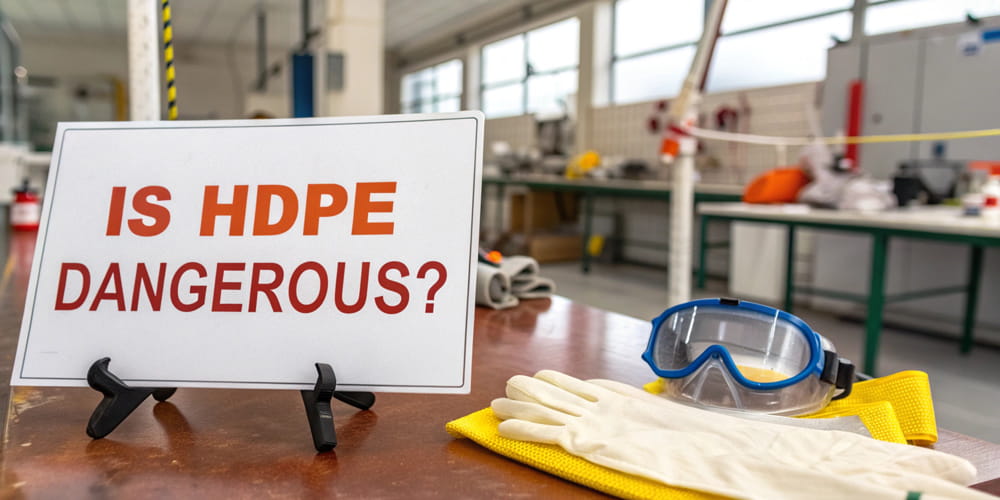
Policies and Registrations
HDPE’s safety is confirmed by various regulatory bodies, such as the U.S. Food and Drug Administration (FDA) and European Union regulations. The FDA acknowledges HDPE as safe for food contact, while the EU’s Konafas classifies it as safe for consumer use under specific conditions. These certifications ensure that HDPE meets strict safety criteria for use in materials that come into contact with humans. Common items made from HDPE include milk jugs, water bottles, cutting boards, kitchen utensils, and medical plastics used within recognized clinical standards. Its widespread use in everyday products further underscores its safety and reliability.
The Science Behind HDPE’s Safety
Understanding the chemical properties of HDPE helps clarify why it is considered safe for most applications:
- Non-Leaching Nature: HDPE does not leach harmful chemicals into food or liquids, making it a trusted choice for packaging.
- High Melting Point: With a melting point of approximately 120-180°C, HDPE retains its integrity under most conditions of everyday use.
- Stability: The polymer’s molecular structure remains stable over time, minimizing the risk of chemical degradation.
Still, responsible use is necessary. For instance, exposing HDPE to conditions outside its design specifications (e.g., extreme heat) could potentially lead to the release of harmful substances, raising the question: Is HDPE dangerous when improperly used?
Environmental Considerations
While HDPE is generally safe for humans, its environmental implications must be addressed:
- Recyclability: HDPE is 100% recyclable, which reduces its environmental footprint. Recycling programs significantly extend the lifecycle of HDPE products.
- Decomposition Concerns: HDPE can take hundreds of years to decompose in landfills, contributing to long-term environmental issues.
Addressing these concerns through sustainable practices can help ensure that HDPE remains a valuable and responsible material for future generations.
Is HDPE Toxic When Heated ?
Under normal conditions, HDPE is generally safe, but its properties change significantly when exposed to high temperatures. Like other thermoplastics, HDPE has a melting point between 120°C and 180°C (248°F to 356°F), which means it can melt, deform, or emit harmful fumes when subjected to heat.
Heating HDPE beyond its melting point can result in the release of toxic fumes, including hydrocarbons and aldehydes, which can be hazardous to health. Additionally, the material’s structural integrity weakens when heated, causing it to become more flexible and lose its intended strength. To prevent these risks, it is essential to avoid heating or halting HDPE beyond its recommended temperature range. In industrial settings, special precautions should be taken to control the temperature and ensure the safe handling of heated HDPE.
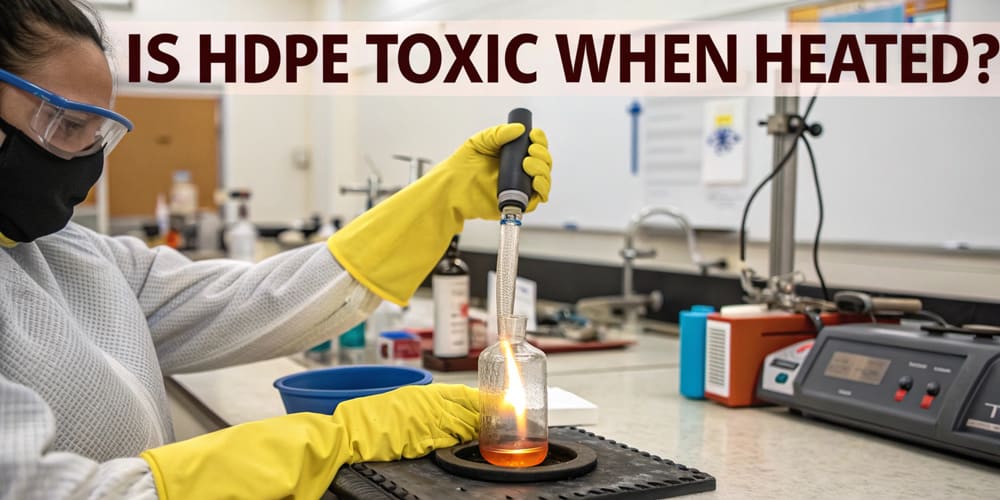
Is HDPE Toxic to Touch ?
A common question often arises: is HDPE dangerous, particularly in direct contact with humans? Addressing this concern requires examining the material’s properties and evaluating scientific evidence surrounding its use.
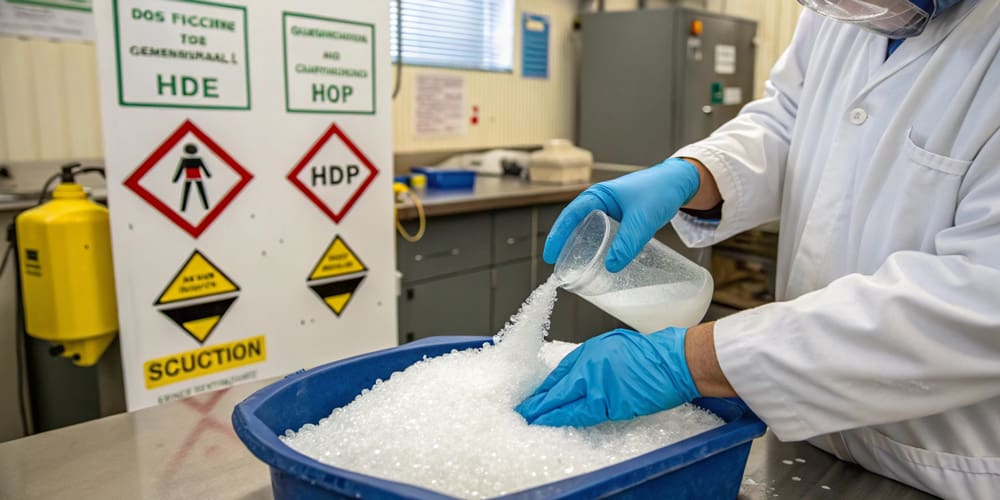
Contact Safety of High-Density Polyethylene
Is high-density polyethylene toxic to humans when touched? The consensus from extensive research is that it is not. Studies demonstrate that HDPE does not leach harmful chemicals through the skin, making it inherently safe for direct contact. Its inert chemical structure prevents it from interacting with the skin or releasing substances that could pose health risks. Unlike other plastics, HDPE does not degrade into toxic particles, even when exposed to environmental stressors.
Products designed for daily use frequently incorporate HDPE due to its proven safety and robustness. For instance, household storage bins, cutting boards, and playground equipment often rely on high-density polyethylene. These items underscore the material’s non-toxic nature, as they are frequently touched by people, including children.
Comparisons with Other Plastics
To better understand the safety of HDPE, comparing it with other commonly used plastics is helpful. A frequent comparison is made between HDPE and polyvinyl chloride (PVC). While both materials are widely used, they differ significantly in terms of toxicity and environmental impact.
PVC is known to emit harmful substances such as dioxins, especially when exposed to heat or during degradation. This characteristic raises valid concerns about its safety for human contact or use in sensitive applications. On the other hand, HDPE does not produce or release such dangerous chemicals, even under harsh conditions. This key difference reinforces the answer to whether is HDPE dangerous: it is not.
Another comparison involves polyethylene terephthalate (PET). While PET is generally considered safe for food-related uses, it lacks the chemical resistance and toughness of HDPE. For harsher environments where durability and resistance to chemical reactions are critical, HDPE emerges as the superior choice.
Environmental Considerations
Although HDPE is considered safe for human use, it poses significant environmental challenges due to its non-biodegradable nature. The material can persist in the environment for hundreds of years, contributing to plastic pollution in landfills and oceans. As it breaks down, HDPE forms microplastics that infiltrate ecosystems, posing indirect risks to human health through contamination of food chains and the release of harmful chemicals during improper disposal or incineration. To mitigate these impacts, it’s crucial to support recycling efforts, proper waste management, and the development of biodegradable alternatives to reduce HDPE’s environmental footprint.
HDPE stands out for its recyclability, being widely accepted in recycling programs across the globe. Compared to many other plastics, HDPE has a high reuse rate and is processed efficiently, making it a more environmentally friendly option. This recyclability significantly reduces its overall environmental impact, addressing concerns about its potential harm. The broader question of whether HDPE is dangerous is mitigated by its recyclability, making it a sustainable material in many industries.
With its combination of low toxicity, high durability, and chemical resistance, HDPE offers unique advantages over other plastics. It is safe for direct human contact and food storage, as evidenced by its use in products like cutting boards and playground equipment, which endure harsh conditions without breaking down into harmful substances. Scientific studies affirm its safety, showing that HDPE does not degrade into microplastics or leach toxic materials, even under extreme conditions. The widespread use of HDPE in everyday products, from food containers to pipelines, highlights its reliability, safety, and sustainability, further reducing concerns about its impact on human health and the environment.
Conclusion
HDPE is a remarkably useful material that has no record of being hazardous to human life. It is safe and has high wearing capabilities for use in areas like food containers and other gaskets, seals, and other industrial products.
Is high density polyethylene a toxic material? In ordinary usage conditions, it is clear that HDPE does not pose a risk to human health. But it should be very carefully heated and the possible effect on the environment should not be disregarded.
- Handle and use HDPE products strictly according to their assigned uses and do not expose them to high temperatures.
- Compared to any other type of packaging material, recycle HDPE where ever possible without causing harm to the environment.its environmental impact raises concerns.


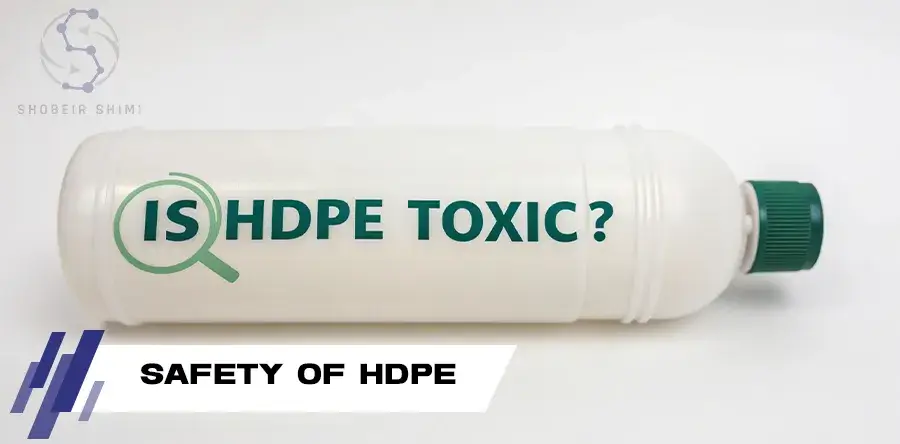
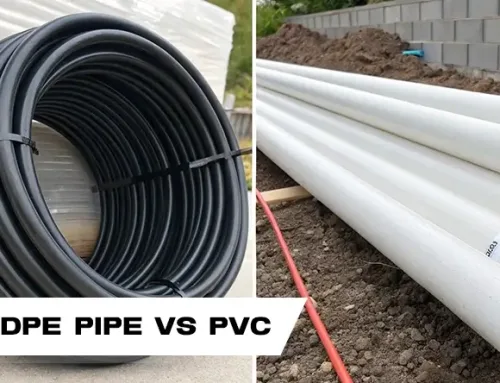
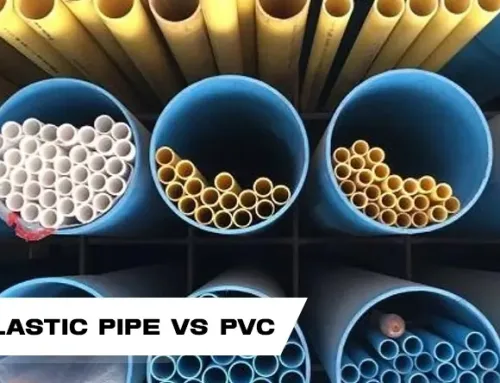

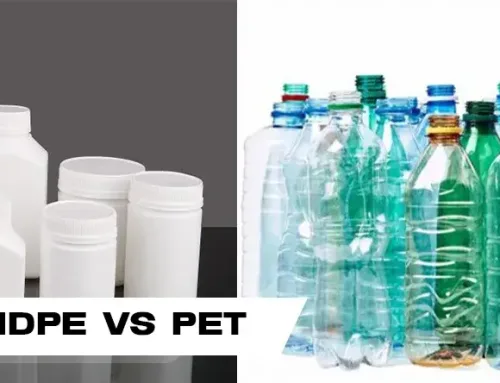
Leave A Comment